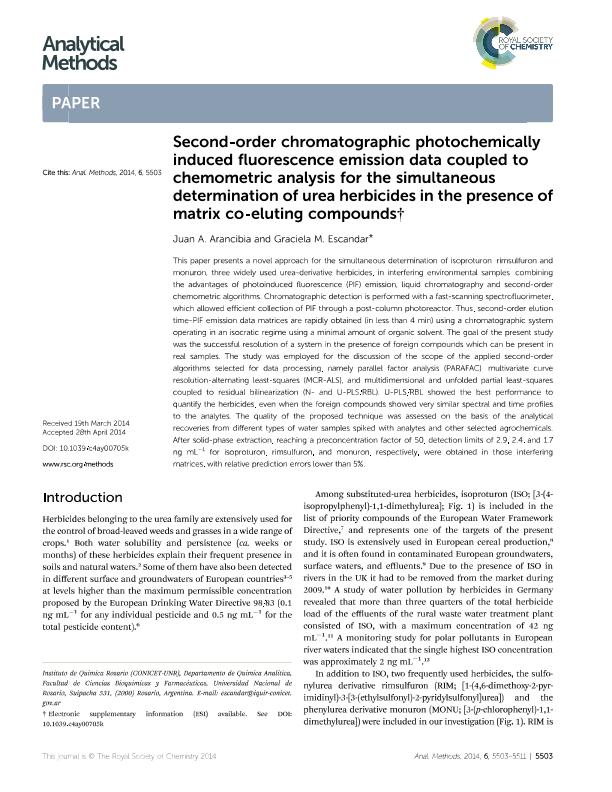Mostrar el registro sencillo del ítem
dc.contributor.author
Arancibia, Juan Alberto

dc.contributor.author
Escandar, Graciela Monica

dc.date.available
2017-12-05T17:24:59Z
dc.date.issued
2014-08
dc.identifier.citation
Arancibia, Juan Alberto; Escandar, Graciela Monica; Second-order chromatographic photochemically induced fluorescence emission data coupled to chemometric analysis for the simultaneous determination of urea herbicides in the presence of matrix co-eluting compounds; Royal Society of Chemistry; Analytical Methods; 15; 8-2014; 5503-5511
dc.identifier.issn
1759-9660
dc.identifier.uri
http://hdl.handle.net/11336/29737
dc.description.abstract
This paper presents a novel approach for the simultaneous determination of isoproturon, rimsulfuron and monuron, three widely used urea-derivative herbicides, in interfering environmental samples, combining the advantages of photoinduced fluorescence (PIF) emission, liquid chromatography and second-order chemometric algorithms. Chromatographic detection is performed with a fast-scanning spectrofluorimeter, which allowed efficient collection of PIF through a post-column photoreactor. Thus, second-order elution time-PIF emission data matrices are rapidly obtained (in less than 4 min) using a chromatographic system operating in an isocratic regime using a minimal amount of organic solvent. The goal of the present study was the successful resolution of a system in the presence of foreign compounds which can be present in real samples. The study was employed for the discussion of the scope of the applied second-order algorithms selected for data processing, namely parallel factor analysis (PARAFAC), multivariate curve resolution-alternating least-squares (MCR-ALS), and multidimensional and unfolded partial least-squares coupled to residual bilinearization (N- and U-PLS/RBL). U-PLS/RBL showed the best performance to quantify the herbicides, even when the foreign compounds showed very similar spectral and time profiles to the analytes. The quality of the proposed technique was assessed on the basis of the analytical recoveries from different types of water samples spiked with analytes and other selected agrochemicals. After solid-phase extraction, reaching a preconcentration factor of 50, detection limits of 2.9, 2.4, and 1.7 ng mL−1 for isoproturon, rimsulfuron, and monuron, respectively, were obtained in those interfering matrices, with relative prediction errors lower than 5%
dc.format
application/pdf
dc.language.iso
eng
dc.publisher
Royal Society of Chemistry
dc.rights
info:eu-repo/semantics/openAccess
dc.rights.uri
https://creativecommons.org/licenses/by-nc-sa/2.5/ar/
dc.subject
Urea Herbicide
dc.subject
Second-Order Calibration
dc.subject.classification
Otras Ciencias Químicas

dc.subject.classification
Ciencias Químicas

dc.subject.classification
CIENCIAS NATURALES Y EXACTAS

dc.title
Second-order chromatographic photochemically induced fluorescence emission data coupled to chemometric analysis for the simultaneous determination of urea herbicides in the presence of matrix co-eluting compounds
dc.type
info:eu-repo/semantics/article
dc.type
info:ar-repo/semantics/artículo
dc.type
info:eu-repo/semantics/publishedVersion
dc.date.updated
2017-12-05T15:19:46Z
dc.journal.volume
15
dc.journal.pagination
5503-5511
dc.journal.pais
Reino Unido

dc.journal.ciudad
Londres
dc.description.fil
Fil: Arancibia, Juan Alberto. Consejo Nacional de Investigaciones Científicas y Técnicas. Centro Científico Tecnológico Conicet - Rosario. Instituto de Química Rosario. Universidad Nacional de Rosario. Facultad de Ciencias Bioquímicas y Farmacéuticas. Instituto de Química Rosario; Argentina
dc.description.fil
Fil: Escandar, Graciela Monica. Consejo Nacional de Investigaciones Científicas y Técnicas. Centro Científico Tecnológico Conicet - Rosario. Instituto de Química Rosario. Universidad Nacional de Rosario. Facultad de Ciencias Bioquímicas y Farmacéuticas. Instituto de Química Rosario; Argentina
dc.journal.title
Analytical Methods
dc.relation.alternativeid
info:eu-repo/semantics/altIdentifier/doi/http://dx.doi.org/10.1039/C4AY00705K
dc.relation.alternativeid
info:eu-repo/semantics/altIdentifier/url/http://pubs.rsc.org/en/Content/ArticleLanding/2014/AY/C4AY00705K
Archivos asociados
